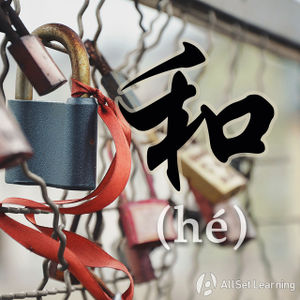Difference between revisions of "Expressing "and" with "he""
| Line 1: | Line 1: | ||
{{Grammar Box}} | {{Grammar Box}} | ||
| + | |||
| + | Whenever you need to list of nouns, whether two of them or more, 和(hé) is there to help you out! | ||
| + | |||
== Structure == | == Structure == | ||
| Line 14: | Line 17: | ||
<div class="liju"> | <div class="liju"> | ||
| − | * <strong>我</strong> <em>和</em> <strong>我 姐姐</strong> 一起 到 公园。 | + | * <strong>我</strong> <em>和</em> <strong>我 姐姐</strong> 一起 到 公园。<span class="trans">My sister and I arrived at the park together .</span> |
| − | * 我 喜欢 <strong>啤酒</strong> <em>和</em> <strong>葡萄酒</strong>。 | + | * 我 喜欢 <strong>啤酒</strong> <em>和</em> <strong>葡萄酒</strong>。<span class="trans">I like beer and wine.</span> |
| − | * <strong>小李</strong> <em>和</em> <strong>小王</strong> 一起 工作。 | + | * <strong>小李</strong> <em>和</em> <strong>小王</strong> 一起 工作。<span class="trans">Little Li and Little Wang work together.</span> |
</div> | </div> | ||
Revision as of 03:53, 29 January 2013
-
Level
-
Similar to
-
Used for
-
Keywords
Whenever you need to list of nouns, whether two of them or more, 和(hé) is there to help you out!
Structure
The most common way to express "and" in Chinese is with 和 (hé). It's important to note that 和 can only be used to link nouns. Verbs (or whole sentences) should not be linked with 和.
Noun 1 + 和 + Noun 2
Examples
- 我 和 我 姐姐 一起 到 公园。My sister and I arrived at the park together .
- 我 喜欢 啤酒 和 葡萄酒。I like beer and wine.
- 小李 和 小王 一起 工作。Little Li and Little Wang work together.
See also
- Expressing "In Addition" with "haiyou"
- "In Addition" as "lingwai"
- Expressing "Not Only… But Also"
- Combining Verbs with "bing"
Sources and further reading
Books
- Basic Patterns of Chinese Grammar (pp. 74-5) →buy
- Chinese: An Essential Grammar, Second Edition (pp. 14-5) →buy



